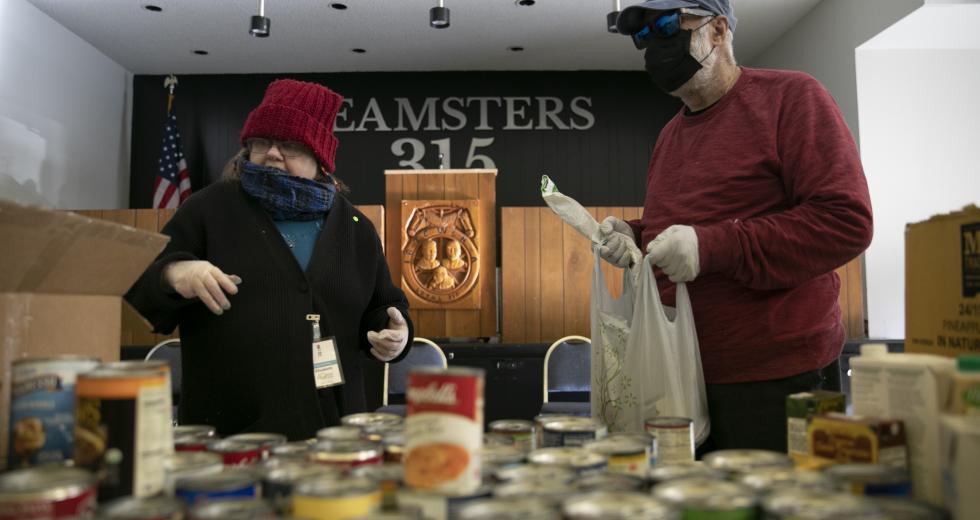A line of 500 to 600 people standing six feet apart snaked around a parking lot and multiple city blocks in downtown Los Angeles. Many were hotel and restaurant workers, Dodger Stadium employees and airline chefs.
All had lost their jobs or were working reduced hours amid the coronavirus pandemic.
One by one, they walked down a row of gloved volunteers who packed bags with spaghetti sauce, canned meat, kidney beans, frozen whole chickens, sliced ham, milk, fresh apples, dry milk, bread and more. It was the second day of a pop-up distribution that served 1,600 people.
Click here for more coronavirus coverage
Across the state, the need for food assistance is growing amid the coronavirus pandemic as businesses shut down, hundreds of thousands of Californians lose wages and seniors and the ill are isolated at home. It’s yet another indicator of the harsh toll the pandemic will take on the state’s working class.
During normal times food banks across the state serve about 2 million Californians each year.
The volume of calls to Alameda County’s emergency food bank hotline increased fivefold, from 40 calls Monday to 200 Wednesday. Half were people who never had used the food bank before, said Michael Altfest, director of community engagement and marketing.
With unprecedented donations coming in this week, nonprofits are coming up with creative solutions to meet the demand, including distributing food in parking lots and possibly teaming with the National Guard to pack and deliver food for those who can’t leave their homes.
Bay Area food banks are in early conversations with DoorDash, Lyft and other companies that could deliver food directly to people’s doors. The Silicon Valley’s food bank may partner with the non-profit Catholic Charities to deliver bags to people who are homebound.
Hannah Jones, 5, pulls a cart full of free meals to her family
car at Sankofa Academy. Children and their families from anywhere
in the district can pick up multiple days worth of lunches and
breakfasts from a dozen sites across the city during the mandated
school closure. (Photo by Anne Wernikoff for CalMatters)
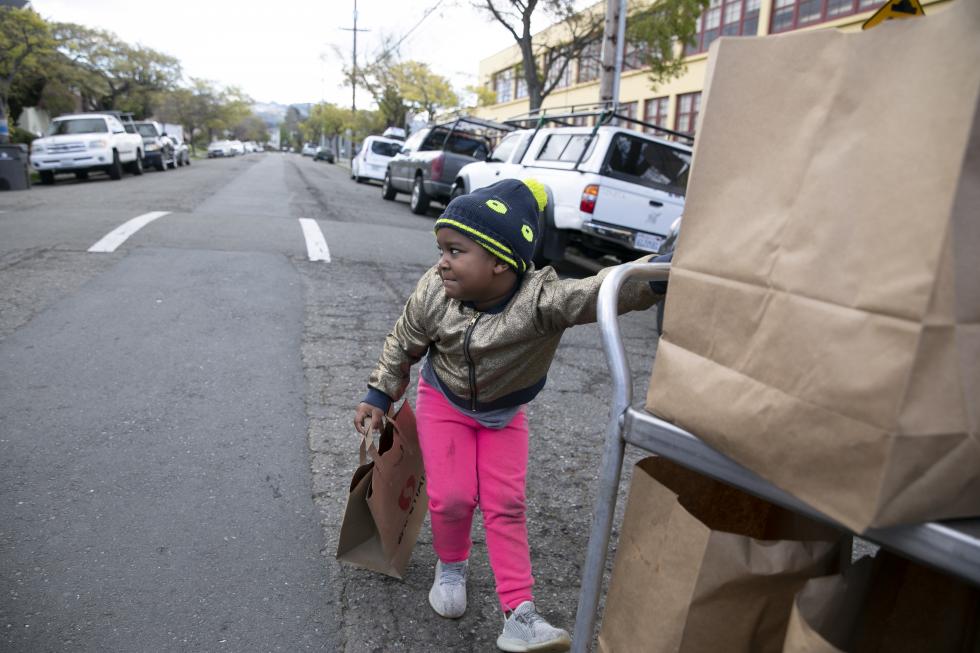
There has “absolutely” seen a spike in demand over the last few days at the Los Angeles Regional Food Bank, said Chief Development Officer Roger Castle. He expects the surge to continue, perhaps even worsen.
“The demand is probably from hourly employees not earning as much or being laid off completely, families that have children that rely on school lunches… and seniors that may not be able to get out to stores to get the food they need,” Castle said.
In one indication that the worst is yet to come, the state received 80,000 unemployment applications on Tuesday, compared to 40,000 a few days before and the typical load of about 2,000 per day, Gov. Gavin Newsom said in a live streamed address on Wednesday.
At a drive-thru style food distribution at the Lady of Refuge church south of downtown San Jose, volunteers estimated they served 50% more households than usual, said Leslie Bacho, chief executive officer of the Second Harvest of Silicon Valley Food Bank. Most are working families, she said. The first car arrived an hour and a half in advance to secure a spot in line.
Daniel Jones, far left, with his daughter and niece, pick up two
days worth of lunches and breakfasts for the family’s seven
children at Sankofa Academy in Oakland. Jones, a contract
commercial driver, has been out of work for more than two weeks
and worries about how to cover expenses after paying next month’s
rent. (Photo by Anne Wernikoff for CalMatters)
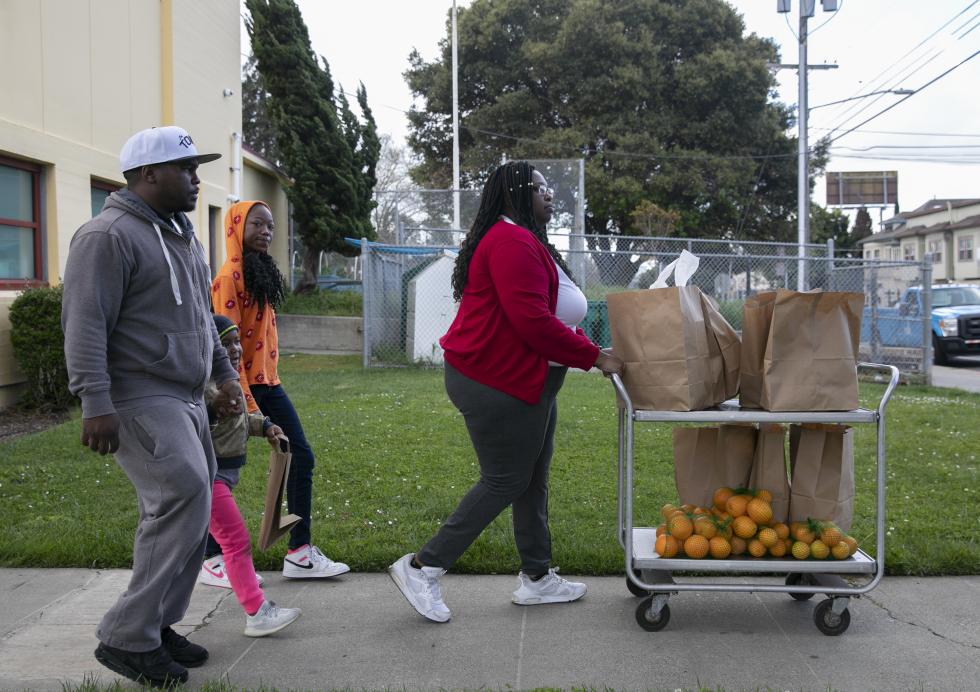
“We thought when the COVID crisis first hit, maybe we’d see fewer clients showing up at our sites,” Bacho said. “We have not seen that at all. We’ve seen an increase.”
Newsom put California’s National Guard force of 22,000 on alert to help California’s communities address the spread of the virus, including distribution of food.
After the Loma Prieto earthquake in 1989, the National Guard partnered with the Second Harvest Food Bank of Santa Cruz. U.S. Rep. Jimmy Panetta said he met yesterday with four National Guard personnel at that food bank to assess needs.
“Unlike other major disasters, this is a disease that does not draw people out, it drives them back home,” Panetta said. “These food banks rely on volunteers, they rely on people to get the food to the most vulnerable who are out there.”
But food banks are facing precipitous drops in volunteers. “The National Guard could fill that void,” Panetta said.
Food Banks Open for Business
California’s food banks are sending a clear message: We are open and we will stay open. Food banks are an “essential business” to address hunger, not subject to closure under shelter-in-place orders.
“We are a grocery story for low-income people and so we have to stay open,” said Lisa Sherrill, communications director for the Contra Costa and Solano Food Bank.
For now, bolstered by donations, including $250,000 from the Los Angeles Chargers, the Los Angeles food bank is more than prepared, with its warehouses stocked with more than 11 million pounds of food, Castle said. The Silicon Valley food bank has received more than $6 million in donations, primarily from a group of wealthy tech moguls spearheaded by Facebook Chief Operating Officer Cheryl Sandberg.
While many distribution sites have closed, others are popping up. In San Francisco and Marin County, more than 90 distribution sites have closed but the food bank that serves both counties has set up six new sites at schools.
At Oakland Unified schools, families can pick up 15 pound bags from the food bank alongside drive-thru free and reduced meal services. Other food banks said they would launch similar distributions soon.
Daniel Jones picked up several bags of food at a distribution at Sankofa Academy in Oakland on Thursday. Out of work for two and a half weeks, the commercial driver applied for a job at Amazon, but hasn’t heard back.
“After paying rent for the next month, (I’m) not sure what we’re gonna do,” said Jones, whose household includes his four children and three nieces and nephews. “(I’m) willing to work wherever I can work.”
On Thursday, President Donald Trump signed into law a coronavirus relief bill that includes $400 million for food banks, $500 million towards grocery money assistance for pregnant women and mothers with young children who lose work and $250 million to provide home-delivered and pre-packaged meals to low-income seniors.
Newsom has extended the eligibility period by 90 days for safety net benefits like food stamps, Medi-Cal, welfare and in-home supportive services.
“I Want to Shelter in Place”
Food bank volunteer Trish Ackerman, 65, wears a mask and gloves
as she fills her own grocery bag at Teamsters 315 Hall in
Martinez. Ackerman, who suffers from asthma, says she continues
to staff the food bank despite coronavirus concerns because
“there’s a lot of seniors that depend on us.” (Photo by Anne
Wernikoff for CalMatters)

Arlene Krauss is scared. The 75-year-old has an autoimmune disease that causes muscle weakness.
“If I got that virus, I would be dead,” Krauss said.
The cafeteria at her affordable senior home in Redwood City has cancelled daily hot meals. So has a nearby senior day center. She’s not one to ask for friends’ help, a sentiment common among seniors. After running dangerously low on groceries, she braved a trip to the store, but it felt like “playing Russian roulette.”
“I want to shelter in place but it’s very different for the people in my situation who don’t have a car and don’t have people who can help them,” Krauss said.
Many people, like Krauss, aren’t even aware of food banks. Dozens of people have asked CalMatters how they’re supposed to get food and supplies under Newsom’s directive that California’s 5.7 million seniors and millions more with chronic conditions stay home because of their vulnerability to coronavirus.
There are home-delivery programs in place, but they can’t meet the need. Just under 220,000 seniors receive federally-funded meals at group settings or home delivery programs like Meals on Wheels.
One option is to set up grocery deliveries with vendors that offer it like Safeway or Amazon, said Kim McCoy Wade, director of California in a live streamed conversation with CalMatters reporters. She emphasized that the best option is to enlist a friend or neighbor to help, perhaps “someone you might not have asked a week ago.”
“We are in a different world and we all need to be reaching out to offer help and to ask for help,” McCoy Wade.
Food bank representatives encouraged anyone in need of food to call either 211 or the emergency hotline listed on their local food bank’s website. Seniors can seek guidance and assistance by calling their Area Agencies on Aging.
–
Anne Wernikoff contributed to this reporting. Jackie Botts is a reporter at CalMatters. This article is part of The California Divide, a collaboration among newsrooms examining income inequity and economic survival in California.
Recommended For You
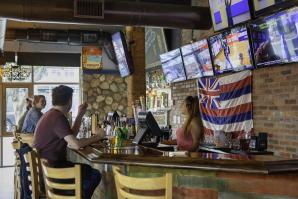
Local Businesses Struggle as Coronavirus Changes Our Daily Lives
On a bleary Monday morning in Sacramento with the Dow Jones industrial average tanking, on its way to a 2,997 point drop and its worst day since 1987, Greater Sacramento Economic Council President and CEO Barry Broome offered advice for local business owners that he knows won’t be popular.

Sacramento Metro Chamber Launches Rapid Response Tool for Businesses
Online hub provides resources for businesses affected by the coronavirus
In response to the crisis of the coronavirus pandemic and the rapidly evolving set of challenges it presents for businesses and workers, in addition to public health, the Sacramento Metro Chamber of Commerce has launched a Rapid Response tool on its website.
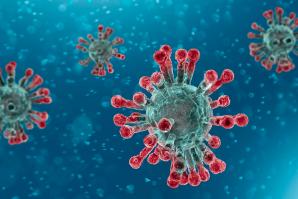
Where California Stands with Coronavirus Testing Right Now
Coronavirus testing has been plagued by confusion, delays and chaos, with the number of available, usable tests far outstripped by the need. The situation, health care providers and experts say, has impaired their ability to know how many people have the virus — but a significantly larger number, they suspect, than that confirmed by state and federal officials.



